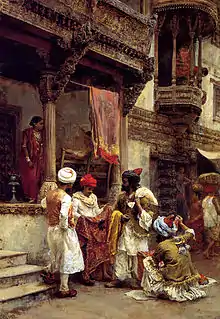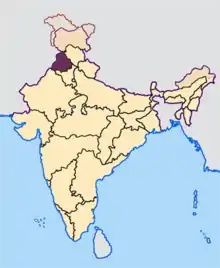Mashru
Mashru (Mushroo, Mashroo, Misru) was a blended striped cloths made of silk and cotton. Mashru was an old handwoven satin silk variety of the Indian subcontinent. The Mashru is a warp faced fabric, In weave cotton yarn goes down and silk comes up that produces a cloth with a silk face and cotton back.[1][2] Mashru was produced in Punjab, and western parts[3] of India.[4][5][6][7][8][9]

The word Mashru means permitted, driven from Mashry in Arabic, and misry/misru refers to a mixture in the Sanskrit language.[10][5][11][12]
Texture and types
Texture
Mashru was a mix of silk and cotton, although satin but a thick and heavy cloth with less lustrous and feminine nature like pure silk.[13][14]
Types
There were varieties of Mashru clothes, Gulbadan, and Sufi, among few leading examples of this category. Mashru was a coarser variety of silk clothes, and it was less expensive than pure silk.[7]
Bahawalpur and Multan was famous for its Shuja khání silks (mixed silk cloths).[15]
Mentions
Mashru is explicitly mentioned in the Ain-i-Akbari under silken kinds of stuff. Mashru or Mushrues mashrū' means 'lawful.' Unlike pure silk, the blend was lawful. Hence it was an acceptable type of cloth among Muslim men. [2][3][6][11][16]
- "Pure silk is not allowed to men, but women may wear the most sumptuous silk fabrics" (Yusuf Ali, op. cit. 90, seq.)[1]
Use
Mashru with silk face and cotton inside was useful for various dresses and household items.[8][9] During the Mughal period Mashru was used for the costumes of courtiers and nobles.[17]
"All Mushroos wash well, especially the finer kinds, used for bodices, petticoats, and trousers of both sexes." [18]
See also
References
- Yule, Sir Henry; Burnell, Arthur Coke (1996). Hobson-Jobson: The Anglo-Indian Dictionary. Wordsworth Editions. p. 707. ISBN 978-1-85326-363-7.
- ''The ordinary orthodox Muslim was only anxious to wear clothes of simple material like linen and to avoid silk , velvet , brocade or fur and coloured ... Mashru - Canonically allowed cloth , i . e . , mixed silk and cotton stuff , was worn , because a Muslim must not wear a dress of pure silk ... 61 Ain - i - Akbari , Blochmann , I , 89'' PAGE 39 A Social History of Islamic India - Page 39books.google.co.in › books Mohammad Yasin · 1958https://www.google.co.in/books/edition/A_Social_History_of_Islamic_India/Rz16lub2uRgC?hl=en&gbpv=1&bsq=M
- ''The ikat velvet pieces which have been located so far and can be identified as Indian are similar in style to the mashru being woven in Western India . ... for the basic foundation and this may have been prepared specially for the conservative Muslim who did not use silk thread next to ... 19 The Ain - i - Akbari also mentions that Akbar received textiles signed by Giyatyad - Din Ali Naqshband as a part of the ...'' Handwoven Fabrics of India - Page 56 Jasleen Dhamija, Jyotindra Jain · 1989
- Mukhopādhyāẏa, Trailokyanātha (1888). Art-manufactures of India: Specially Compiled for the Glasgow International Exhibition, 1888. Superintendant of Government Printing. p. 347.
- Gillow, John; Barnard, Nicholas (2008). Indian Textiles. Thames & Hudson. p. 98. ISBN 978-0-500-51432-0.
- Crill, Rosemary (2006). Textiles from India: The Global Trade : Papers Presented at a Conference on the Indian Textile Trade, Kolkata, 12-14 October 2003. Seagull Books. p. 331. ISBN 978-1-905422-17-3.
- Baden-Powell, Baden Henry (1872). Hand-book of the Economic Products of the Punjab: With a Combined Index and Glossary of Technical Vernacular Words. Printed at the Thomason Civil Engineering College Press. pp. 64, 65.
- MATHEWS, KOLANJIKOMBIL (2017). Encyclopaedic Dictionary of Textile Terms: Four Volume Set. Woodhead Publishing India PVT. Limited. p. 912. ISBN 978-93-85059-66-7.
- Cola, P. R. (1867). How to Develope Productive Industry in India and the East: Mills and Factories for Ginning, Spinning, and Weaving Cotton; Jute and Silk Manufactures... Etc., Etc. With Estimates and Plans of Factories. Virtue and Company. p. 328.
- Textiles and Dress of India: Socio-economic, Environmental and Symbolic Significance. University of Minnesota. 1992. p. 69.
- Dhamija, Jasleen (2002). Woven Magic: The Affinitity [sic] Between Indian and Indonesian Textiles. Dian Rakyat. ISBN 978-979-523-567-5.
- ''In India , they are known under such names as bandha , mashru , patolu , telia rumal , chitki or simply ' tie ... A famous contemporary Arab traveler , Ibn Battuta , describes the rich gifts the Sultan of Delhi bestowed on the ... Their name means ' permitted ' , but it is also related to the Sanskrit word misru , meaning ' mixed ' .'' Page 223 Museum für Völkerkunde und Schweizerisches Museum für Volkskunde Basel, Marie-Louise Nabholz-Kartaschoff · 1986https://www.google.co.in/books/edition/%E3%82%A4%E3%83%B3%E3%83%89%E3%81%AE%E4%BC%9D%E7%B5%B1%E6%9F%93%E7%B9%94/XzbrAAAAMAAJ?hl=en&gbpv=1&bsq=The+word+Mashru+means+permitted+in+Arabic&dq=The+word+Mashru+means+permitted+in+Arabic&printsec=frontcover
- Yule, Sir Henry; Burnell, Arthur Coke (1996). Hobson-Jobson: The Anglo-Indian Dictionary. Wordsworth Editions. p. 912. ISBN 978-1-85326-363-7.
- ''Mashru , for instance , a double layered material with a thick cotton base and covered with almost a single stranded silken warp and woof , was presumably an Indian innovation . Varieties containing silk and cotton admixtures gained greater currency in the empire , more particularly after the ... Ain - i - Akbari , Persian , ( ed . ) ...'' Indian Journal of History of Science - Volumes 17-18 - Page 120 1982
- Calcutta Review. University of Calcutta. 1891. p. 258.
- Jadia, Umesh (1999). Kachchh: An Introduction to the Historical Places, Textile Embroideries, Arts & Crafts Etc. of Kachchh. Radhey Screen Printing. p. 28.
- General, India Office of the Registrar (1962). Census of India, 1961: Gujarat. Manager of Publications. p. 66.
- (Forbes Watson, op. cit. 97.)




